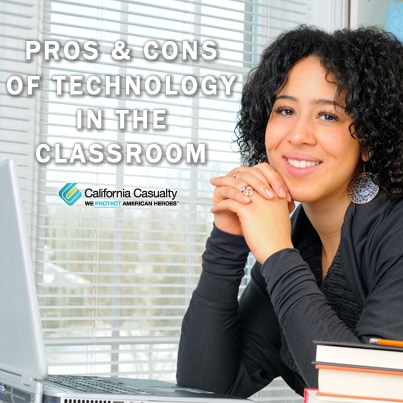The face of education is changing with the rapid acceleration of smartphones, learning pads and computers into schools. While new electronic learning options open exciting opportunities for engagement and creative possibilities, there is a raging debate about its effectiveness. Many are also warning about some negative implications.
Edutopia contributors have been writing about technology integration for years. Their website has a dedicated section about the adoption of technology in the classroom and how it is changing learning. But judging by the point and counterpoint, there’s much more still to be decided. Here are some of the pros and cons to merging electronics into the classroom.
Pros
Multiple studies show advanced learning systems can enhance student engagement and motivation. A Stanford Center for Opportunity Policy in Education study found when implemented properly, the use of tablets and computers has produced significant gains in student achievement while boosting engagement. One of the paper’s conclusions is that while all students benefit from technology, the greatest impact was on those most at-risk.
Using computers and tablets in class has shown to improve student cooperation and collaboration. It has also created a new approach to class time called, “blended learning” – combining digital content with face-to-face discussions and activities. An NEA Today article discussed the pros and cons of allowing bring your own device policies being introduced in many school districts to aid the “flipped” classroom strategy.
Other noted advantages of technology in the classroom are:
- Easier communication with parents and students
- Faster turn-around on papers and grading
- Quicker access to information
- Addition of learning games and other activities for students
- Introducing students to careers and technology based applications for the future
- Integrating the apps and devices children are already using into learning and research opportunities
Many experts say there is no going back on advancing technology, and many educators are convinced it has opened new doors for teaching and engagement.
Cons
The other side of the debate warns that unbridled use of technology in the classroom can dumb-down student learning, waste taxpayer dollars, and leave some teachers and students lost in a maze of technological difficulties leading to lack of adaptation.
First, there’s the expense. Many school districts have jumped headfirst in the technology pool without thinking about the effects. A classic example is Los Angeles Unified School District’s $100 million dollar iPad fiasco. The deal was scrapped after issues surfaced with late delivery, incomplete software and teacher complaints about inadequate time and support to integrate the systems. Some experts warn that many school districts and administrators are allocating money for technology because they believe they have to, not necessarily because they need it. Also, many districts don’t factor in the cost of updates and how quickly new technology becomes outdated.
Another problem was highlighted in an article by technology writer Benjamin Herold, which found students using digital readers retained less information. They were more likely to skim the texts and were more distracted by links and other digital extras than students who read from a book or magazine. Herold advises that there needs to be a better understanding of comprehension issues before e-readers are mainstreamed in the classroom.
Other authors have raised concerns about cyberbullying and students who may seem savvy, but are actually not as adept they appear to be in using their devices for deeper learning and research applications.
And in a recent study, educator Katie Davis and Harvard professor Howard Gardner found the reliance on apps by today’s youth may be harming creativity and could inhibit reflective thinking, which they say affects the ability to build empathy and understanding of others.
Other problems with technology:
- Wasted time with connectivity and downloading or buffering issues (insufficient band-width)
- Teachers and students frustrated by inadequate technology support
- Lack of training and understanding of how to integrate technology into lesson plans and learning
- Incompatibility with existing systems
- Not enough computers, laptops or tablets for all students
- Unreal expectations that technology will improve student performance
So, what is the solution? A recent summit of top educators (including 2014 National Teacher of the Year Sean McComb), ed-tech advocates and policy makers developed six key points to help make integration of technology in the classroom more successful:
- Allocate more time for professional development with technology
- Reimagine the ecosystem and the offerings for professional development
- Move from 20th– to 21st– century training
- Change the school culture to encourage trust and experimentation
- Redefine leadership, recognizing teachers and students may have more technological expertise
- Create meaningful mentorship opportunities
While it appears nobody can stop the advance of new learning systems, many are urging decision makers, administrators and teachers to take a long look at what e-readers, laptops and tablets can do and to understand the implications of improper implementation.
And whether it’s for tablets, electronic learning games, or new books and pencils, California Casualty is ready to help with the $2,500 Academic Award. The funds can be used for any classroom supplies and materials that will benefit students. The information and application can be found at www.calcasacademicaward.com.
https://www.scpr.org/news/2015/04/17/51093/schools-dealing-with-aftermath-of-lausd-s-ipad-fia/
https://neatoday.org/2012/07/19/should-schools-embrace-bring-your-own-device/
https://www.edutopia.org/technology-integration-guide-implementation
https://www.edutopia.org/technology-integration
- Educators Receive $1,000 Athletic Grants from California Casualty - May 22, 2024
- Music & Arts Grant Recipients – 2023 - December 1, 2023
- How to Tell When You Need New Brakes - November 20, 2023

